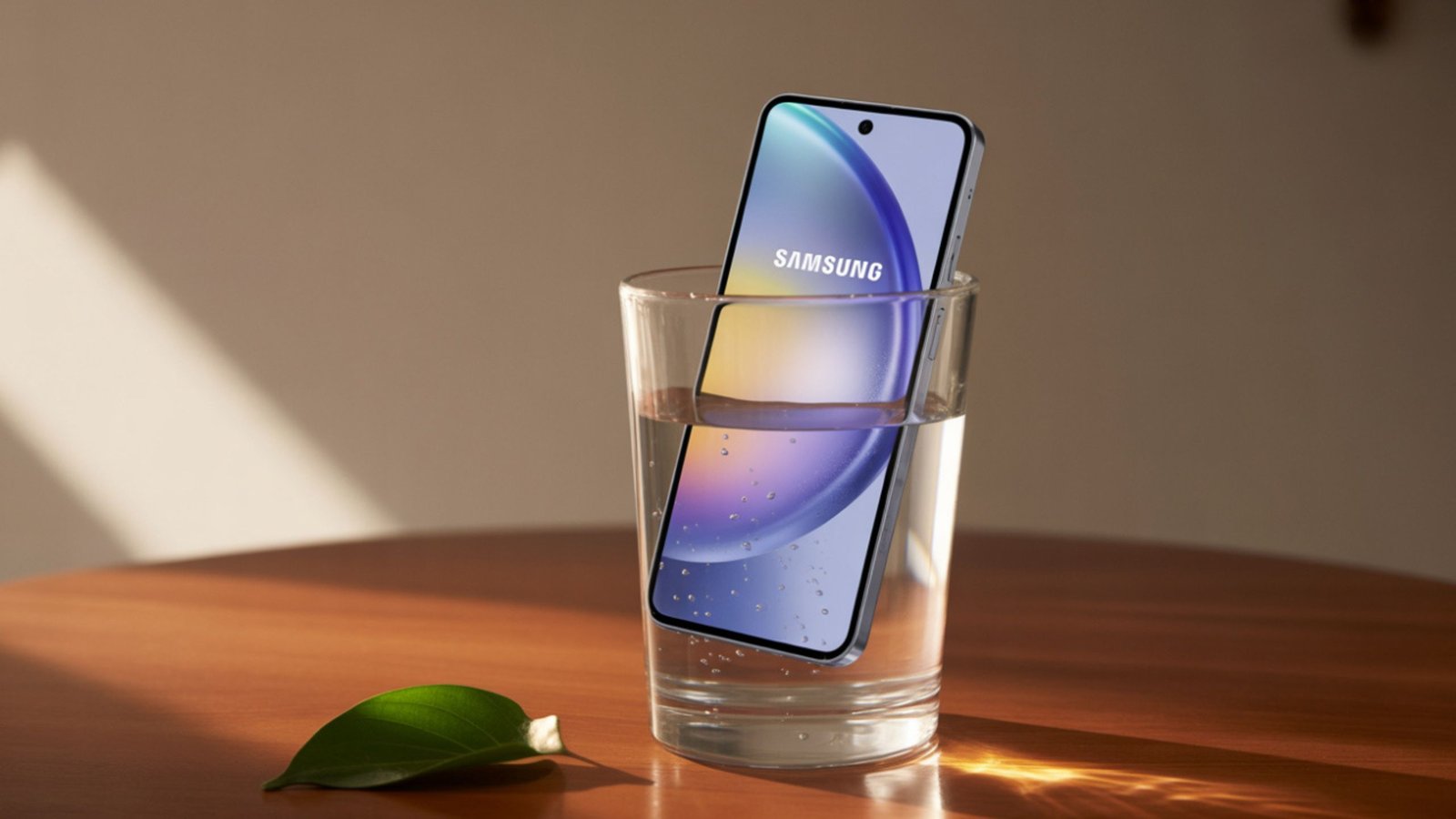Samsung Galaxy A53 Waterproof– When considering a smartphone purchase, one of the most common questions users ask is: “Is the Samsung Galaxy A53 waterproof?” The answer is slightly more nuanced. While the Galaxy A53 is not fully waterproof, it has a solid IP67 water resistance rating, protecting it against everyday accidents such as spills, splashes, and even short-term submersion in fresh water. We explore the water resistance capabilities of the Galaxy A53, as well as its limitations and practical usage tips, to ensure your device remains protected for the long term.
Understanding the Samsung Galaxy A53 IP67 Rating
The IP67 certification is an international standard that defines how well a device can resist dust and water.
- IP stands for Ingress Protection.
- The first digit (6) refers to dust protection, meaning the Galaxy A53 is completely dust-tight.
- The second digit (7) refers to water protection, meaning the device can survive immersion in fresh water up to 1 meter deep for 30 minutes.
This makes the Samsung Galaxy A53 ideal for handling accidental splashes, light rain, or short drops in water without immediate damage.
Can the Samsung Galaxy A53 Handle Rain and Accidental Spills?
Thanks to its IP67 rating, the Samsung Galaxy A53 is safe to use in rainy weather or when exposed to small amounts of liquid. If you accidentally spill coffee, tea, or water on the phone, it is designed to resist short-term exposure without malfunctioning.
This feature provides significant peace of mind for users who frequently travel or work outdoors. Everyday scenarios like answering calls during a drizzle or handling the phone near the sink won’t be a significant concern.
Limitations of Galaxy A53 Water Resistance
While the Galaxy A53 offers strong water resistance, it’s important to remember that it is not fully waterproof. There are specific conditions where the phone’s protection may fail:
- Saltwater Exposure – The phone is not designed to withstand saltwater, such as oceans or seas. Salt can corrode internal components.
- Chlorinated Water – Pools contain chlorine and other chemicals that may damage seals and internal parts.
- High-Pressure Water Streams – Direct exposure to strong jets, such as in the shower or from a water hose, can push water past protective seals.
- Long-Term Submersion – While it can handle up to 30 minutes underwater at 1 meter, submerging it longer increases the risk of water damage.
- Aging and Wear – Over time, seals and adhesives can weaken, reducing the effectiveness of the water resistance.
Precautions to Take After Water Exposure
If your Samsung Galaxy A53 comes into contact with water, certain precautions will help maintain its performance:
- Dry Thoroughly Before Charging – Never connect the charging cable if the device or charging port is wet. Please wait until it is scorched.
- Pat Dry Immediately – Use a soft, lint-free cloth to absorb moisture. Avoid using heat sources like hair dryers, as they may damage internal seals.
- Check Ports and Openings – Ensure the SIM tray, speakers, and USB-C port are fully dry before use.
- Avoid Repeated Submersion – Although water-resistant, repeated exposure may compromise the phone’s integrity.
Is the Samsung Galaxy A53 Suitable for Swimming or Underwater Photography?
The Galaxy A53 is not recommended for swimming or underwater photography. While its IP67 rating provides short-term protection, it was not engineered for prolonged underwater use. Underwater conditions, particularly with moving water, can exceed the pressure limits of the IP67 rating.
If underwater photography is essential, consider purchasing a special waterproof case designed for smartphones. These cases offer enhanced sealing and allow safe underwater operation without damaging your Galaxy A53.
Real-Life Water Resistance Performance
User experiences and independent tests confirm that the Galaxy A53 survives accidental drops in sinks, bathtubs, and puddles. For instance:
- A quick fall into a water basin shows no long-term damage when the device is immediately dried.
- Exposure to light rain or sweat during workouts has minimal effect.
- Intentional underwater filming, however, often results in muffled audio, touchscreen issues, or long-term degradation.
These tests reaffirm that the Samsung Galaxy A53 is best considered water-resistant, not waterproof.
Comparing Galaxy A53 Water Resistance to Other Samsung Phones
Samsung provides varying degrees of water protection across its lineup:
- Samsung Galaxy S22 and newer models – IP68 certified, meaning protection up to 1.5 meters of water for 30 minutes.
- Samsung Galaxy A53 – IP67 offers slightly less depth protection.
- Older Galaxy A-series models often lacked water resistance entirely.
This places the Galaxy A53 in a strong position for mid-range smartphones, balancing affordability with durable water protection.
How to Protect Your Galaxy A53 Against Water Damage Long-Term
While the built-in IP67 resistance is reliable, additional precautions can extend your phone’s longevity:
- Use a Protective Case – Water-resistant or waterproof cases add extra defense.
- Avoid Hot and Humid Environments – High heat can weaken adhesive seals.
- Inspect for Damage – Cracks in the screen or frame may allow water ingress.
- Service with Care – Only use authorized service centers, as improper repairs can compromise sealing.
- Regular Cleaning – Keep charging ports free from dust and debris to maintain integrity.
Weap Up: Is the Samsung Galaxy A53 Waterproof?
The Samsung Galaxy A53 is not waterproof but water-resistant with an IP67 rating. This makes it highly reliable for accidental splashes, spills, and brief immersion in fresh water. However, it should never be mistaken for a fully waterproof device suitable for underwater photography, swimming, or long-term submersion. By taking the proper precautions and understanding its limitations, you can enjoy the durability and reliability of the Galaxy A53 without fear of everyday water-related accidents.
Ask Follow-up Question from this topic With Google Gemini: Is the Samsung Galaxy A53 Waterproof? Complete Guide to Water Resistance

Selva Ganesh is a Computer Science Engineer, Android Developer, and Tech Enthusiast. As the Chief Editor of this blog, he brings over 10 years of experience in Android development and professional blogging. He has completed multiple courses under the Google News Initiative, enhancing his expertise in digital journalism and content accuracy. Selva also manages Android Infotech, a globally recognized platform known for its practical, solution-focused articles that help users resolve Android-related issues.




This information is priceless. Thanks!
So glad I found this before buying.
This is exactly what I was looking for.
I hope more phones adopt this level of protection.
What’s the difference between IP67 and IP68? This is helpful.
Thanks for confirming it’s a solid water resistance rating.
This is good news for clumsy people like me.
I’m glad it can handle spills and rain. That’s all I really need.
Great article. Very informative and to the point.
Glad to know my phone is safe from everyday water exposure.
Solid IP67 rating is a huge plus.
Good to see a phone with a decent IP rating.
This confirms my choice to get this phone.
I wonder if a case affects the water resistance.
Perfect explanation of a complex topic.
I’ve had phones ruined by water before. This is a must-have feature.
Such a helpful breakdown.
I’ll be sure to follow the usage tips.
I’m impressed with the level of detail.
Excellent explanation of the IP rating.
This is an essential feature for me. Thanks for the breakdown!
Helps a lot with my purchase decision.
Great insights into the phone’s capabilities.
This answers all my questions about the A53’s durability.
I always need to be careful around water.
This is exactly what I was looking for.
Good to know it can handle accidental submersion for a short period.
I’m relieved to hear it’s protected against common accidents.
I always tell my friends to check the IP rating.
This article is very reassuring.
A must-read for anyone considering the Galaxy A53.
I hope more phones adopt this level of protection.
Thanks for this comprehensive guide.
What’s the difference between IP67 and IP68? This is helpful.
Thanks for confirming it’s a solid water resistance rating.
This is good news for clumsy people like me.
The A53 seems quite durable for a mid-range phone.
I was wondering about its water resistance. This article clears it up perfectly.
This is a game-changer for me.
I’ve always been confused about ‘water resistance’ vs ‘waterproof’. This helps a lot.
This article just saved me from making a mistake.
What about chlorinated pool water? Does the rating still apply?
This is why I always check the specs before buying.
I’m glad it can handle spills and rain. That’s all I really need.
Does the water resistance degrade over time?
What a useful summary!
Everyday accidents are the biggest threat
So it’s splash-proof